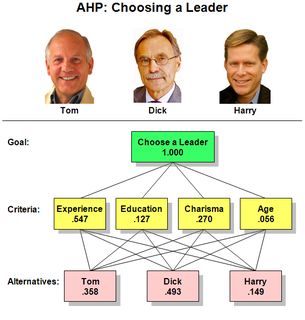Related Research Articles
Quality function deployment (QFD) a method developed in Japan beginning in 1966 to help transform the voice of the customer into engineering characteristics for a product. Yoji Akao, the original developer, described QFD as a "method to transform qualitative user demands into quantitative parameters, to deploy the functions forming quality, and to deploy methods for achieving the design quality into subsystems and component parts, and ultimately to specific elements of the manufacturing process." The author combined his work in quality assurance and quality control points with function deployment used in value engineering.
In the social sciences, scaling is the process of measuring or ordering entities with respect to quantitative attributes or traits. For example, a scaling technique might involve estimating individuals' levels of extraversion, or the perceived quality of products. Certain methods of scaling permit estimation of magnitudes on a continuum, while other methods provide only for relative ordering of the entities.
Questionnaire construction refers to the design of a questionnaire to gather statistically useful information about a given topic. When properly constructed and responsibly administered, questionnaires can provide valuable data about any given subject.
Quantitative marketing research is the application of quantitative research techniques to the field of marketing research. It has roots in both the positivist view of the world, and the modern marketing viewpoint that marketing is an interactive process in which both the buyer and seller reach a satisfying agreement on the "four Ps" of marketing: Product, Price, Place (location) and Promotion.

A Likert scale is a psychometric scale commonly involved in research that employs questionnaires. It is the most widely used approach to scaling responses in survey research, such that the term is often used interchangeably with rating scale, although there are other types of rating scales.

Multiple-criteria decision-making (MCDM) or multiple-criteria decision analysis (MCDA) is a sub-discipline of operations research that explicitly evaluates multiple conflicting criteria in decision making. Conflicting criteria are typical in evaluating options: cost or price is usually one of the main criteria, and some measure of quality is typically another criterion, easily in conflict with the cost. In purchasing a car, cost, comfort, safety, and fuel economy may be some of the main criteria we consider – it is unusual that the cheapest car is the most comfortable and the safest one. In portfolio management, managers are interested in getting high returns while simultaneously reducing risks; however, the stocks that have the potential of bringing high returns typically carry high risk of losing money. In a service industry, customer satisfaction and the cost of providing service are fundamental conflicting criteria.

In the theory of decision making, the analytic hierarchy process (AHP), also analytical hierarchy process, is a structured technique for organizing and analyzing complex decisions, based on mathematics and psychology. It was developed by Thomas L. Saaty in the 1970s; Saaty partnered with Ernest Forman to develop Expert Choice software in 1983, and AHP has been extensively studied and refined since then. It represents an accurate approach to quantifying the weights of decision criteria. Individual experts’ experiences are utilized to estimate the relative magnitudes of factors through pair-wise comparisons. Each of the respondents compares the relative importance each pair of items using a specially designed questionnaire.

In the design of experiments, optimal designs are a class of experimental designs that are optimal with respect to some statistical criterion. The creation of this field of statistics has been credited to Danish statistician Kirstine Smith.
Positional voting is a ranked voting electoral system in which the options or candidates receive points based on their rank position on each ballot and the one with the most points overall wins. The lower-ranked preference in any adjacent pair is generally of less value than the higher-ranked one. Although it may sometimes be weighted the same, it is never worth more. A valid progression of points or weightings may be chosen at will or it may form a mathematical sequence such as an arithmetic progression, a geometric one or a harmonic one. The set of weightings employed in an election heavily influences the rank ordering of the candidates. The steeper the initial decline in preference values with descending rank, the more polarised and less consensual the positional voting system becomes.

A sound level meter is used for acoustic measurements. It is commonly a hand-held instrument with a microphone. The best type of microphone for sound level meters is the condenser microphone, which combines precision with stability and reliability. The diaphragm of the microphone responds to changes in air pressure caused by sound waves. That is why the instrument is sometimes referred to as a sound pressure level meter (SPL). This movement of the diaphragm, i.e. the sound pressure, is converted into an electrical signal. While describing sound in terms of sound pressure, a logarithmic conversion is usually applied and the sound pressure level is stated instead, in decibels (dB), with 0 dB SPL equal to 20 micropascals.
The rational planning model is a model of the planning process involving a number of rational actions or steps. Taylor (1998) outlines five steps, as follows:
A decision matrix is a list of values in rows and columns that allows an analyst to systematically identify, analyze, and rate the performance of relationships between sets of values and information. Elements of a decision matrix show decisions based on certain decision criteria. The matrix is useful for looking at large masses of decision factors and assessing each factor's relative significance by weighting them by importance.
Performance-Based Building Design is an approach to the design of any complexity of building, from single-detached homes up to and including high-rise apartments and office buildings. A building constructed in this way is required to meet certain measurable or predictable performance requirements, such as energy efficiency or seismic load, without a specific prescribed method by which to attain those requirements. This is in contrast to traditional prescribed building codes, which mandate specific construction practises, such as stud size and distance between studs in wooden frame construction. Such an approach provides the freedom to develop tools and methods to evaluate the entire life cycle of the building process, from the business dealings, to procurement, through construction and the evaluation of results.
In decision theory, the weighted sum model (WSM), also called weighted linear combination (WLC) or simple additive weighting (SAW), is the best known and simplest multi-criteria decision analysis (MCDA) / multi-criteria decision making method for evaluating a number of alternatives in terms of a number of decision criteria.
The weighted product model (WPM) is a popular multi-criteria decision analysis (MCDA) / multi-criteria decision making (MCDM) method. It is similar to the weighted sum model (WSM). The main difference is that instead of addition in the main mathematical operation now there is multiplication.
The decision-making paradox is a phenomenon related to decision-making and the quest for determining reliable decision-making methods. It was first described by Triantaphyllou, and has been recognized in the related literature as a fundamental paradox in multi-criteria decision analysis (MCDA), multi-criteria decision making (MCDM) and decision analysis since then.
This is a worked-through example showing the use of the analytic hierarchy process (AHP) in a practical decision situation.
The Technique for Order of Preference by Similarity to Ideal Solution (TOPSIS) is a multi-criteria decision analysis method, which was originally developed by Ching-Lai Hwang and Yoon in 1981 with further developments by Yoon in 1987, and Hwang, Lai and Liu in 1993. TOPSIS is based on the concept that the chosen alternative should have the shortest geometric distance from the positive ideal solution (PIS) and the longest geometric distance from the negative ideal solution (NIS).
Electoral systems are the rules for conducting elections, a main component of which is the algorithm for determining the winner from the ballots cast. This article discusses methods and results of comparing different electoral systems, both those which elect a unique candidate in a 'single-winner' election and those which elect a group of representatives in a multiwinner election.
References
- ↑ S. Pugh (1981) Concept selection: a method that works. In: Hubka, V. (ed.), Review of design methodology. Proceedings international conference on engineering design, March 1981, Rome. Zürich: Heurista, 1981, blz. 497 – 506.
- ↑ "What is a weighted decision matrix?". Weighted Decision. 9 October 2012. Retrieved 26 May 2022.